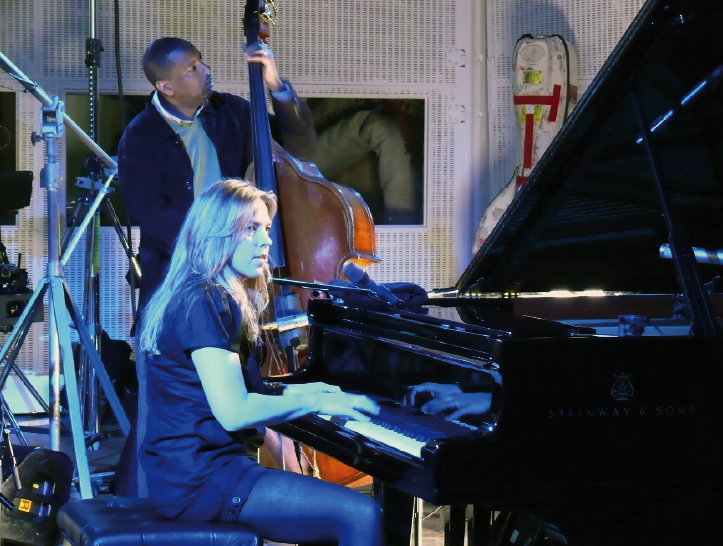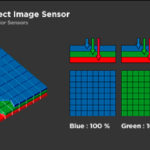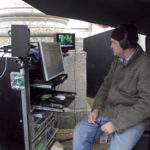
Live From Abbey Road
Posted on May 7, 2010 by Alex Fice
Live From Abbey Road is a music show that is hard to label. It’s a combination of great artist performances and a ‘reality show’ element all served up with lush high definition and of course finely crafted 5.1 audio. We speak to some of the core team about how they achieve this fine balanceMake it sound like a CD and look like a film”. Producer Peter Van Hooke’s eleven word mission statement for Live From Abbey Road, now in its second season on Channel 4 in the UK and a number of broadcast territories (142) elsewhere.
Abbey Road could be called an institution but that’s feint praise, which the studios have been living with since the heydays. There was a time when artists, maybe operating abroad, even thought that the studios weren’t a booking space but more of a museum. Because of such myths Abbey Road has worked harder than most to present itself as an icon of supreme quality, a custodian of recording history and a technology power house – some balancing act! It is with Live From Abbey Road that this juggling act is honed to perfection and a bone fide new music programming format is born.
If you haven’t seen the programme the premise is that each show will have three artists of various genres and one of these should be ‘up and coming’. They then perform at least three numbers usually in studio 2 (the Beatles’ studio), six cameras film these performances and the whole thing is mixed with interviews and general ‘reality’. As a theory you might say ‘that sound good but where’s the magic?’. In practice the effect is enhanced with some modern broadcasting technologies namely 5.1 surround sound and high definition.
Series one was shot in HDCAM and Series Two in DVCPRO HD. HDCAM caused its own problems as Post Production Manager John Mills explains: “We were shooting HDCAM and HDV so it was a mixture of formats and then we were digitising at DV for an offline edit, that would get locked and we would re-conform. We did get problems with matching timecodes and all that kind of thing.”
The production, apart from mixing the transmission sound, is done in Abbey Road with a core team of under ten people. The video post is all done in a couple of rooms near the studios’ gear entrance where Apple’s Final Cut Pro and an Xsan build the edit and Apple’s Color matches it all up. Far from a ‘hobbyist’ set up this a very professional installation with a 20TB Xsan with FCP in one room and three FCPs and Color in the other. All cameras are Panasonic models with the HDX900 providing the performance footage and the interviews. However this wasn’t always the case as ‘minicams’ were used initially in Series One until editor Keith Mottram banned them because of their low resolution look and poor lenses. The Panasonic DVCPRO HD format allows the offline/online tradition to be avoided. The edit is done in DVCPRO HD, in 1440×1080, then is ‘uprezzed’ to 1920×1080 Pro Res HQ for Color work, titles and output to HDCAM SR. The team doesn’t have the luxury of choosing a camera and then making a workflow on the back of it. They have chosen a format with a proven workflow, anything else would leave less time for the ‘creative decisions’ that producer Peter Van Hooke sees as the show’s heart.
Director Annabel Jankel is a veteran of the pop video when they were produced as mini masterpieces for bands like Elvis Costello, Talking Heads, Tom Tom Club, Donald Fagen and Miles Davis. She went on to ‘invent’ anarchic ‘robot head’ Max Headroom and then became a Hollywood film director. Her ‘vision’ for Live From Abbey Road is where the ideas for shooting each band are germinated. DoP Kelvin Richards then takes those ideas and produces a look with his crew and his lights: “Annabel and I will listen to the music of the bands beforehand to get a vibe from them. Annabel gets a ‘flavour’, which is the best way to describe it. She may say about a particular band ‘Crème Brûlée, something sweet’, and it will be like a one or two line description. My interpretation of that will result in the look. For example when we did Brian Wilson she wanted a very serious look with slightly cool colours on him. I’ll take that and give him harsh lighting but then warm up the band to contrast that so I take the lead from Annabel but have quite a free rein to interpret it.
“We tend to predominately light with HMIs unlike most other shows which tend to use tungsten for cost and other reasons really. So I tend to use daylight settings really and variations of. The ‘variations of’ is the thing, for example we shoot with hi-def lenses or we shoot with film lenses with Pro35 adapters or we mix them up on the same band. So you might have a couple of cameras with the Pro35s and others with HD lenses. So that’s something different going on which will hopefully compliment the performance. Once Keith gets the material he cuts it his way which is actually quite an unorthodox way as he builds his edits rather than going straight in to a performance. He might hold back on some of the angles until the music starts to vibe and then will introduce angles.”
To produce a look from an abstract idea for the same shooting space with roughly the same band placement is a tall order. But the show doesn’t have live music show disciplines like say Top Of The Pops did so you will see other cameras in your shot, you will see crash zooms and steadicam wobble. Kelvin has to bring his whole bag of tricks to the table though to illicit something custom to each artist. “Last series we had 40 artists and this new one had 30, the reality is how do you make each one of those bands different or at least make the space their own? Sometimes I sit down for days working out what to do lighting wise, sometimes we ‘re working up to seven days in advance. I’m not trying to say ‘This band sounds blue or gold or whatever’ but I’m looking for something that will add to their edge.”
Kelvin also has to work under certain restrictions to do with Abbey Road, as in not being able to hang any lights from anywhere so his attitude is to light for film sets which harks back to producer Peter Van Hooke’s film mission statement. Kelvin’s background is luckily film drama so playing everything off the floor isn’t a forced measure. “We have what I call a ‘dirty’ set which means we can actually see stands, we can see other operators, that adds to the dirtiness of it. We’re not trying to say this is a sterile environment, it is the nuts and bolts of the recording and filming. That allows me to put lights in more acute or intimate angles than I would if we were working off a studio floor with a lighting rig. With a lighting rig everything tends to look the same.”
With up to six camera operators on the floor at any one time Kelvin was one of the operators in Series one but soon realised he was needed elsewhere: “Because we’re shooting hi-def the focus and the exposure are crucial. So once I’ve lit it and plotted out where the cameras need to go then I’m back more or less with Annabel, but I have my own monitor so I can actually talk directly to the operators to keep their exposure under control. The cameras aren’t connected to a rack system with an engineer controlling exposure, we’re relying on the cameramen to set their own exposure so they still need guidance and for focus which is critical.”
The first series, as mentioned, used the HDCAM format with Sony 750 camcorders. There was a move towards Panasonic and Kelvin decided the best thing to do was to do a test. “So we had the Sony 750 that we used last year for reference, the Varicam and the HDX900 which was a fairly new camera at that time. I did side by side comparisons, exposure over and under, gain structure, colour rendition, the whole bit as if I was doing a drama. The 900 when shooting straight out of the box with default settings was by far the best camera. It gave us at least another stop to a stop and a half of sensitivity which meant we could back off the lights and use less on some occasions.”
As for in-camera looks, Kelvin did use some in Series One but hasn’t done as much for Series Two relying on lighting technique and a bit of grading to saturate or desaturate accordingly. “You talk to any DP and they will say that the colourist is taking a bigger chunk out of what they do, we like to have control at the time of shooting, but that’s just the nature of the beast.”
Heavy grading isn’t something that happens on this show probably because of all the effort that goes into the capture and obviously the time element. Kelvin’s lighting armoury is extensive and he uses it all: “I tend to play with bigger lights, we’ve used 6ks in there, 4ks, 2ks, 1ks, I’ve used Chinese lanterns, Cyc lights, Ground Rows and Flo Banks. I tend to use the Flo Banks more because they are a slightly softer light although we use Ground Rows for theatrical effect. There’s a classic example of how we arrive at a look, Annabel was talking about a Vaudeville kind of vibe for The Good, The Bad and The Queen in Series One and I had this image of the Gangs Of New York with the knife throwing scene and that was my inspiration for that set.
Being a television format that you can’t pigeonhole means that various production disciplines have to be weaved together to achieve what the team ultimately wants. What is the show? Is it a reality show with music, is it a purist’s music show with a license to explore celebrity or is it, at its root, a documentary. It is this third option that editor Keith Mottram feels most comfortable with. “I didn’t want anything that resembled a music video cut, I’m after the drama of the day, trying to find the narrative. You do get this especially when bands are on tour, you can really pick up on their relationship, how they glance at each other while playing. The reality side of it is for me what makes the show.”
These varied disciplines also mean 60 hours of high definition footage to turn into one show with graphics, together with mixing a 5.1 music track – so a kind of ‘super’ doc. But it’s not such a chore to plough through the footage because a lot of it are music performances which are encouraged to be one-take, Keith explains his method of working: “We pick the takes we need and have some extras for coverage, so in an edit I’m working with maybe 18 streams of DVCPRO HD. The first cut I’ll do is a live cut effectively, so I plough through and get a basic edit, I’ll use that to get my personal flavour of what’s going on. I’m trying to find the narrative, the story of the day. After I’ve done that initial cut I’ll start the second pass and that will be a structure pass. I’m not bothered at that stage about the individual shots I’m more bothered about getting the rhythm of the edit. It is a music driven show not a visual show. On the third and fourth passes I’ll be looking to insert the shots I’ve seen and try and fit the narrative to the musical structure of the song.
That’s very important to me and very different. Every time I watch music cuts on TV I always completely amazed that the editors never really follow musical phrases, they don’t seem to think about how the songs are structured themselves.”
Keith admits that in the second series he has pushed the reality side more, being careful not to tip in to that ‘genre’. This was Keith’s and Director Annabel Jankel’s decision based on feedback from the first series, but sometimes getting artists to ‘open up’ without goofing around too much is a problem, Keith uses Brian Wilson as an example: “We got nothing from him, so that one is probably most like a reality show because we didn’t get any conversation from him, no interaction just a little bit of stuff between him and his band. We are at the mercy of what we get.”
In practice Keith is scanning the rushes at more than real time to find the footage he wants, not a way of working for everyone but having laid out his initial edit he can then find the nods, winks, looks and nuggets that he wants to tell the story. Keith will also ask other production staff if they had seen anything memorable that might help in telling the story, then it’s a matter of finding roughly what time it was and start scanning for it.
There’s no doubt that a show of this type, if there is another such as show, needs a ‘hub’ where everything arrives and is dealt with. Keith seems to fill that role and is already thinking about next season and the possible return of a smaller camera form factor: “I’d like to test some of the new lipstick style HD cameras especially now that you get a few different lenses, cameras like the Iconix. I want to be much closer to the lens testing next season, Kelvin Richards does a fantastic job, but I don’t like mixing up HD lenses and Pro35 in the same scene, I like all the lenses to match. Quite often I think the Pro35 is used too much, we are quite often shooting at stops like T4 and it is no different to using high quality HD glass, in fact we get better results.”
As for the main camera, would Keith want to veer away from such a workable solution with DVCPRO HD, what about the camera of the moment RED?: “I would not touch a RED at the moment, everyone I know who has shot with one has said that it has reliability issues. I personally would think about using RED for my own projects but not for this. Would the RED ever be suitable for us? Possibly if the reliability went up, maybe four builds from now if it’s completely solid, if the recording times came good, if the reboot time came good. On a set like ours, its busy and we don’t want to stop, if a musician wants to do another take and we’ve run out of tape or batteries we do it and we might lose a bit of a song, it’s very rare though. So the last thing we need to be added in to the mix is something else to slow us down because that will upset the artist. I don’t need 4k its completely pointless, if the RED shot a straight 1080 then that would be a different matter.
“I would possibly be happy moving to P2 if we still have a relationship with Panasonic next year. I’m very impressed with the images I’ve seen from the 3000 and the new Varicam. It’s damn close to the (Sony) F23, which is the ideal camera for me. If I had a choice I would say shoot everything on the Genesis or F23, I do like having the tapes and am a bit nervous about an all P2 workflow but it is something we are going to test. Time wise we have worked very well with a tape-based format, as much as I’m interested in improving image quality it can’t be at the expense of the workflow.
“The Panasonic HDX900 has a very nice aesthetic, but they do lose on resolution. That’s fine in a lot of cases but there are particular instances in our set that the resolution does cause a bit of cross hatching, I’m very keen to move to a full 1920×1080 product. At the end of the day I think the cameras are SD and a half. Having said that the end result is completely fine, because we have such a tight workflow there is very little loss between the shooting and the output, the image holds up very well throughout the workflow, but there is room for improvement.”
Ultimately Live From Abbey Road is a quality product that enables us the viewer to peep in to a world many of us would never have seen before. The fact that this world has been heavily prepared for us doesn’t ruin the illusion.













